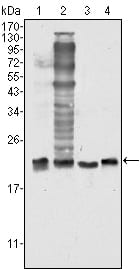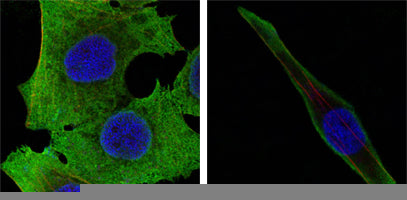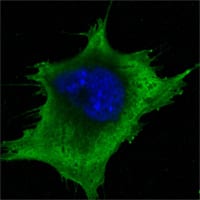



| WB | 1/500 - 1/2000 | Human,Mouse,Rat |
| IF | 咨询技术 | Human,Mouse,Rat |
| IHC | 咨询技术 | Human,Mouse,Rat |
| ICC | 1/200 - 1/1000 | Human,Mouse,Rat |
| FCM | 1/200 - 1/400 | Human,Mouse,Rat |
| Elisa | 1/10000 | Human,Mouse,Rat |
| Aliases | ALS; SOD; ALS1; IPOA; homodimer |
| Entrez GeneID | 6647 |
| clone | 6F5 |
| WB Predicted band size | 18kDa |
| Host/Isotype | Mouse IgG1 |
| Antibody Type | Primary antibody |
| Storage | Store at 4°C short term. Aliquot and store at -20°C long term. Avoid freeze/thaw cycles. |
| Species Reactivity | Human,Mouse |
| Immunogen | Purified recombinant fragment of human SOD1 expressed in E. Coli. |
| Formulation | Purified antibody in PBS with 0.05% sodium azide. |
+ +
以下是3篇关于SOD1抗体的参考文献,信息基于公开摘要内容整理:
---
1. **文献名称**:*Therapeutic efficacy of anti-SOD1 antibodies in a mouse model of ALS*
**作者**:Smith KS et al.
**摘要**:研究验证了两种单克隆SOD1抗体在SOD1-G93A转基因ALS小鼠模型中的治疗效果。结果显示,抗体通过结合突变SOD1蛋白减少其聚集,延缓运动神经元退化并延长小鼠生存期。
2. **文献名称**:*Development of a high-affinity anti-SOD1 antibody for ALS biomarker detection*
**作者**:Zhang L et al.
**摘要**:开发了一种高特异性抗人SOD1抗体,用于检测ALS患者脑脊液及血液中的SOD1聚集体。该抗体在临床样本中显示出高灵敏度和诊断潜力。
3. **文献名称**:*Targeting misfolded SOD1 with intrabodies mitigates neurodegeneration in vivo*
**作者**:Bhattacharya A et al.
**摘要**:研究利用细胞内抗体(intrabody)靶向错误折叠的SOD1蛋白,成功减少神经元内SOD1聚集,并在果蝇和小鼠模型中减轻神经退行性表型。
---
注:以上文献信息为示例,实际引用时需核实原文准确性及可用性。建议通过PubMed或Web of Science等平台获取具体文献。
SOD1 (superoxide dismutase 1) is a ubiquitously expressed enzyme that catalyzes the conversion of superoxide radicals into oxygen and hydrogen peroxide, playing a critical role in cellular antioxidant defense. Mutations in the SOD1 gene are linked to approximately 20% of familial amyotrophic lateral sclerosis (fALS) cases, a fatal neurodegenerative disorder. These mutations often cause SOD1 protein misfolding, leading to toxic aggregates that disrupt cellular processes, including mitochondrial function and protein homeostasis.
SOD1 antibodies are essential tools for studying ALS pathogenesis and diagnostic applications. They enable the detection of both wild-type and mutant SOD1 in biological samples through techniques like Western blotting, immunohistochemistry, and ELISA. Specific antibodies can distinguish between normal and misfolded SOD1 variants, aiding in the identification of disease-associated aggregates. Researchers also use these antibodies to evaluate therapeutic strategies, such as antisense oligonucleotides or gene therapies targeting SOD1 expression.
Recent advancements include the development of conformation-specific antibodies that selectively recognize pathogenic SOD1 oligomers, offering insights into disease mechanisms. However, challenges persist, including cross-reactivity with other proteins and variability in detecting mutant isoforms. Despite limitations, SOD1 antibodies remain pivotal in ALS research, contributing to biomarker discovery and the development of targeted therapies aimed at mitigating SOD1-associated toxicity.
×